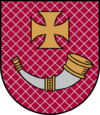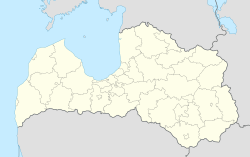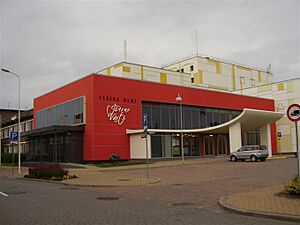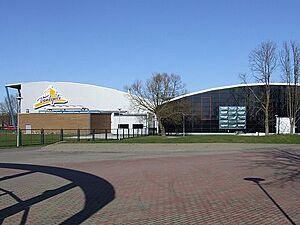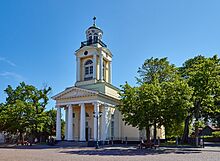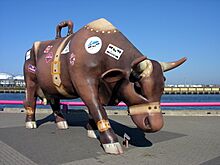Ventspils facts for kids
Quick facts for kids
Ventspils
Livonian: Vǟnta
|
|||||
|---|---|---|---|---|---|
|
State city
|
|||||

Aerial view with the Ventspils Castle and port
|
|||||
|
|||||
| Country | |||||
| Town rights | 1378 | ||||
| Area | |||||
| • Total | Lua error in Module:Wd at line 1,575: attempt to index field 'wikibase' (a nil value). km2 (Formatting error: invalid input when rounding sq mi) | ||||
| • Land | Lua error in Module:Wd at line 1,575: attempt to index field 'wikibase' (a nil value). km2 (Formatting error: invalid input when rounding sq mi) | ||||
| • Water | Expression error: Unexpected < operator. km2 (Formatting error: invalid input when rounding sq mi) | ||||
| Population
(2024)
|
|||||
| • Total | 32,634 | ||||
| GDP | |||||
| • State city | 460,619,000 Euro (2021) | ||||
| • Per capita | 13,900 Euro (2021) | ||||
| Time zone | UTC+2 (EET) | ||||
| • Summer (DST) | UTC+3 (EEST) | ||||
| Postal code |
LV-36(01-21)
|
||||
| Calling code | (+371) 636 | ||||
| Number of city council members | 13 | ||||
Ventspils (Latvian: [ˈvæntspils]) is a city in northwestern Latvia. It is located in the historical Courland region and is the sixth largest city in the country.
In early 2020, Ventspils had about 33,906 people living there. The city is built on the Venta River where it meets the Baltic Sea. It has a special port that doesn't freeze in winter. The name "Ventspils" means "castle on the Venta," which refers to the old Livonian Order's castle by the river.
Contents
Other Names for Ventspils
Ventspils has been known by different names throughout history. In German, it was called Windau.
During the time of the Russian Empire, its Russian name was Виндава (Vindava) or Виндау (Vindau). However, after World War II, the name Вентспилс (Ventspils) became common.
Other names for the city include Livonian: Vǟnta in Livonian, Vindavi in Estonian, and Polish: Windawa in Polish.
History of Ventspils
Ventspils grew around the Livonian Order Ventspils Castle, which was built along the Venta River. The city was officially recognized in 1314. It became an important trading city as part of the Hanseatic League, a powerful group of merchant cities.
Shipbuilding and Colonization
When Ventspils was part of the Duchy of Courland, it became a busy place for building ships. Many warships and trading ships were built here. From Ventspils, the Duke's fleet sailed to start colonies in places like Gambia and Tobago. Shops that worked with metal, amber, and wood also helped the city grow.
Wars and Changes
Ventspils faced tough times during the Polish-Swedish War and the Great Northern War, when it was badly damaged. In 1711, a terrible plague wiped out most of the people living there. In 1795, after the Third Partition of Poland-Lithuania, Ventspils came under the control of the Russian Empire.
Around 1850, shipbuilding and trade became important again. The port was updated in the 1890s and got a railway connection to Moscow. By 1913, it was one of Russia's most successful ports. The number of people living in Ventspils also grew a lot, from 7,000 in 1897 to 29,000 in 1913.
During the German occupation from 1915 to 1919, the population dropped by almost half. Some people returned when Latvia became independent (1918–1940).
Modern Times
In 1939, the Red Army set up a base in Ventspils. During World War II, the city was under Soviet control from 1940, then under German control from 1941 to 1944. Later, under Soviet rule, an oil pipeline was built to Ventspils, making it a main port for exporting crude oil from the USSR.
About 30 miles north of Ventspils is a former Soviet radioastronomy center called VIRAC. Most Latvians didn't know about this center until 1994. After Latvia became independent, the government started to make the city more beautiful to attract tourists.
In 2004, Ventspils hosted a large naval exercise called Baltic Operations XXXIII (BALTOPS). Navies from many countries, including the United States, United Kingdom, and Latvia, took part.
Climate in Ventspils
Ventspils has a climate that is a mix between an oceanic climate and a humid continental climate. This means winters are usually just below freezing, and summers are warm. Ventspils holds the record for the highest temperature ever recorded in Latvia: 37.8 °C (100.0 °F) on August 4, 2014.
| Climate data for Ventspils (1991−2020 normals, extremes 1873−present) | |||||||||||||
|---|---|---|---|---|---|---|---|---|---|---|---|---|---|
| Month | Jan | Feb | Mar | Apr | May | Jun | Jul | Aug | Sep | Oct | Nov | Dec | Year |
| Record high °C (°F) | 8.9 (48.0) |
14.2 (57.6) |
18.6 (65.5) |
26.1 (79.0) |
31.7 (89.1) |
33.1 (91.6) |
34.8 (94.6) |
37.8 (100.0) |
32.2 (90.0) |
22.6 (72.7) |
15.1 (59.2) |
12.5 (54.5) |
37.8 (100.0) |
| Mean daily maximum °C (°F) | 1.2 (34.2) |
1.0 (33.8) |
3.7 (38.7) |
8.9 (48.0) |
13.9 (57.0) |
17.7 (63.9) |
20.9 (69.6) |
21.1 (70.0) |
16.8 (62.2) |
11.1 (52.0) |
6.1 (43.0) |
3.1 (37.6) |
10.5 (50.8) |
| Daily mean °C (°F) | −0.5 (31.1) |
−1.1 (30.0) |
1.3 (34.3) |
5.6 (42.1) |
10.4 (50.7) |
14.5 (58.1) |
17.8 (64.0) |
17.8 (64.0) |
13.8 (56.8) |
8.6 (47.5) |
4.2 (39.6) |
1.3 (34.3) |
7.8 (46.0) |
| Mean daily minimum °C (°F) | −2.6 (27.3) |
−3.3 (26.1) |
−1.1 (30.0) |
2.8 (37.0) |
7.3 (45.1) |
11.5 (52.7) |
14.7 (58.5) |
14.5 (58.1) |
10.8 (51.4) |
6.0 (42.8) |
2.2 (36.0) |
−0.7 (30.7) |
5.2 (41.3) |
| Record low °C (°F) | −31.6 (−24.9) |
−29.5 (−21.1) |
−26.7 (−16.1) |
−12.7 (9.1) |
−4.3 (24.3) |
0.5 (32.9) |
4.2 (39.6) |
2.6 (36.7) |
−2.9 (26.8) |
−8.5 (16.7) |
−15.0 (5.0) |
−25.0 (−13.0) |
−31.6 (−24.9) |
| Average precipitation mm (inches) | 59.3 (2.33) |
46.3 (1.82) |
38.9 (1.53) |
31.6 (1.24) |
36.8 (1.45) |
49.6 (1.95) |
63.5 (2.50) |
75.9 (2.99) |
64.4 (2.54) |
84.8 (3.34) |
70.6 (2.78) |
71.2 (2.80) |
692.9 (27.27) |
| Average precipitation days (≥ 1 mm) | 12 | 10 | 8 | 7 | 7 | 7 | 8 | 10 | 9 | 13 | 13 | 14 | 118 |
| Average relative humidity (%) | 85.9 | 84.9 | 81.6 | 77.6 | 77.2 | 79.1 | 79.2 | 77.7 | 79.3 | 81.2 | 85.0 | 85.4 | 81.2 |
| Mean monthly sunshine hours | 21.2 | 50.4 | 128.1 | 174.4 | 322.2 | 268.8 | 270.4 | 149.2 | 127.6 | 103.3 | 24.4 | 25.1 | 1,665.1 |
| Source 1: LVĢMC | |||||||||||||
| Source 2: NOAA (precipitation days, humidity 1991-2020), infoclimat.fr (sunshine 1991-2020) | |||||||||||||
| Coastal temperature data for Ventspils | |||||||||||||
|---|---|---|---|---|---|---|---|---|---|---|---|---|---|
| Month | Jan | Feb | Mar | Apr | May | Jun | Jul | Aug | Sep | Oct | Nov | Dec | Year |
| Average sea temperature °C (°F) | 2.7 (36.86) |
1.6 (34.88) |
1.0 (33.80) |
3.1 (37.58) |
8.3 (46.94) |
14.3 (57.74) |
18.5 (65.30) |
18.9 (66.02) |
16.4 (61.52) |
11.7 (53.06) |
8.3 (46.94) |
5.4 (41.72) |
9.18 (48.52) |
| Source:seatemperature.org | |||||||||||||
People of Ventspils
At the start of 2017, Ventspils had about 39,447 people. More than half of them (54.3%) were women.
Most of the people in Ventspils (63%) are between 15 and 62 years old. About 14.3% are children aged 0–14, and 22.6% are 62 years or older.
Here's a look at the different groups of people living in Ventspils:
| Ethnic groups | Per cent of total population |
|---|---|
| Latvians | 56.7 |
| Russians | 27.3 |
| Ukrainians | 4.5 |
| Belarusians | 4.2 |
| Poles | 1.0 |
| Others | 6.3 |
Education in Ventspils
Ventspils has several places for higher education and learning:
- Ventspils University College
- Riga Technical University, Ventspils branch
- Riga Teacher Training and Educational Management Academy, Ventspils branch
- College of Law, Ventspils branch
Economy of Ventspils
Ventspils is located at the mouth of the Venta River, where it flows into the Baltic Sea. This makes it a very important ice-free port. A lot of oil and other natural resources from Russia are loaded onto ships here.
Ventspils Airport is one of Latvia's three international airports and is located in the city. The Ventspils High Technology Park helps IT and electronics companies by providing them with necessary facilities and services.
Culture in Ventspils
Every winter, Ventspils hosts the awards ceremony for the Latvian Radio show Musical Bank. It also hosts the national TV selection for the Eurovision Song Contest. In July, the Sea Festival takes place, and in August, there's an annual city festival to celebrate the city's birthday. Other popular events include Ghetto games and Vakara pastaiga.
Several places help make Ventspils a lively cultural city:
- The Theatre House "Juras varti" shows many different kinds of professional performances.
- The Ventspils Museum studies and records the history of Ventspils. It keeps a city chronicle, collects museum items, and does scientific research.
- The Ventspils Library is a public place for culture, education, and information.
- The International Writers and Translators' House is a global center for writers and translators to work.
Sports in Ventspils
Ventspils has great sports facilities. A very popular one is the Olympic Centre 'Ventspils'. It has a basketball hall, an ice hall, a track-and-field arena, and football stadiums. You can also visit the Water Adventure Park, the Seaside Aqua-Park, and the Adventure Park, which becomes the Skiing Hill 'Lemberga hūte in winter.
The city has a basketball team, BK Ventspils, which has won the Latvian championship many times. In the 2001/2002 season, they came in third place in the North European Basketball League (NEBL). Ventspils also has a football team called FK Ventspils that plays in the Virsliga. In 2006, the team won the Latvian championship for the first time.
Adventure Park
Ventspils has an Adventure Park (in Latvian: Piedzīvojumu parks) with lots of fun activities. In summer, you can enjoy a Tube Sliding Track, Airsoft Shooting Range, Bumper boats, a Trampoline Complex, Trampolines with Rubber Ribbons, a Mad Rotor, a Catapult, a Trampoline boat, a Playhouse for children, and Inflatable Attractions.
In winter, you can go skiing, snowboarding, and sledding.
There is also a rodeo track (in Latvian: Rodeļu trase) that you can use all year round.
Tourism in Ventspils
Ventspils has a 600 mm (1 ft 11 5⁄8 in) narrow gauge train, a beautiful beach with dunes, and an observatory with a telescope and a digital planetarium.
Old Town of Ventspils
Ventspils grew quickly as a trading port when the Duchy of Courland and Semigallia was thriving. Many buildings were constructed near the current Market Square, where some old storehouses from the 17th century still stand. A house at the corner of Tirgus and Skolas Streets, built in 1646, is one of the oldest houses of its kind in Latvia.
Next to the Market Square, in an old school building on Skolas street, is the Ventspils House of the Crafts (opened in 2007). The International Writers’ and Translators’ House (opened in 2006) is in the former City Hall building (from 1850) on City-Hall Square. This building was rebuilt to help writers with their creative work and daily needs. Nearby are the recently updated Ventspils Central Library (2006) and the Evangelic-Lutheran Church of Nicholas (1835). The City-Hall Square, Market Square, and Ostas Street Promenade are popular places for walks.
Cow Sculptures
In 2002, a special art event called CowParade took place in Ventspils. Now, several cow sculptures can be found around the city:
- ‘Latvijas melnā’ (Latvian Black Cow) is on the Promenade of Ostas iela.
- ‘Pretim gaismai’ (Towards the Light) usually climbs a lamp post on Pils iela.
- ‘Ms. Moo-Dunk’ the basketball cow is near the Basketball Hall at the Olympic Centre ‘Ventspils’.
- ‘Dzīve ir skaista’ (Life is Beautiful) is in the Children's Park ‘Bērnu pilsētiņa’ (Children's Town).
- ‘Jūras govs’ (Cow of the Sea) is next to the Livonian Order Castle, facing the Venta River.
- ‘Nafta’ (Oil) lives next to the Children's Home ‘Selga’.
- ‘Londonas govs’ (London Cow) greets visitors at the camping site ‘Piejūras kempings’.
There are also three much larger cows:
- ‘Ceļojošā govs’ (Travelling Cow) looks like a giant suitcase and waits for city guests on the Promenade of Ostas iela for photos.
- ‘Govs-Matrozis’ (The Sailor Cow) is a huge blue cow dressed as a sailor, located at the Southern Pier of Ventspils.
- ‘Šūpojošā govs’ (Cow on the Swings) is a big, friendly cow sitting on swings not far from the excursion boat ‘Hercogs Jēkabs’.
Famous People from Ventspils
Many notable people were born or lived in Ventspils:
- Fred Rebell (1886–1968) – a sailor who sailed alone
- Dorothy Dworkin (1889–1976) – a nurse, businesswoman, and giver of money to good causes
- Fricis Kaņeps (1916–1981) – a footballer
- Francis Rudolph (1921–2005) – a painter
- Imant Raminsh (1943) – a composer
- Dzintars Ābiķis (1952) – a politician
- Ģirts Valdis Kristovskis (1962) – a politician
- Sandis Prūsis (1965) – a bobsleigh pilot
- Gundars Vētra (1967) – a basketball star
- Oleg Belozyorov (1969) – a Russian politician and manager
- Ēriks Rags (1975) – a javelin thrower
- Gatis Gūts (1976) – a bobsleigh pilot
- Valērijs Žolnerovičs (1985) – an athlete
- Ingus Janevics (1986) – a speedwalker
- Laura Ikauniece (1992) – an athlete
- Rebeka Ibrahima (1998) – an Olympic weightlifter
- Rūta Kate Lasmane (2000) – an athlete
- Artūrs Šilovs (2001) – an NHL goaltender
Sister Cities
Ventspils has special partnerships with these cities, called "sister cities":
 Lorient, France
Lorient, France Ningbo, China
Ningbo, China Novopolotsk, Belarus
Novopolotsk, Belarus Polotsk, Belarus
Polotsk, Belarus Stralsund, Germany
Stralsund, Germany Västervik, Sweden
Västervik, Sweden
See also
 In Spanish: Ventspils para niños
In Spanish: Ventspils para niños



